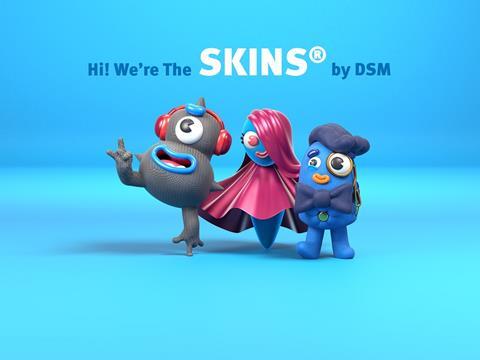
DSM announces the latest addition to its coating resins portfolio; Skins® by DSM. A special series of resins that enhances a key element for graphic and packaging design; touch. The resins, launched via the characters Rubbert Skins®, Silky Skins® and Vel-Veeto Skins® create a world of feel opportunities for food and non-food packaging whether on coated or uncoated paper, board, plastics and even aluminum and let customers engage with products and their design in a new way.
Graphic and packaging solutions have become the extensions of customers’ brand impressions. With modern high-speed coating technologies, simple plastic or carton packages can be transformed into packages that gains sensory attention that support the image of a brand owner or positively affect consumer behavior.
To understand the impact of ‘feel’ for graphic and packaging design, DSM measured and analyzed the feel impact of more than 400 different materials and functional structures via a Haptic Innovation Process. With this knowledge and the insights of the printing and packaging process, the first three Skins® feel coating resins have been developed.
In addition to its nice touch, the rubbery surface of Rubbert® helps with grip and enhances the ergonomics of designs. It works harmoniously with human anatomy or creates more visibility to text and graphics on the shelf.
Silky® silk varnish might be beautiful but has a very practical side too. The low viscosity makes it well suited for use in flexographic printing or varnishing units.
Vel-Veeto® reproduces the classy sensation of velvet to give packaging a premium feel. Due to the resin’s irregular surface landscape plus high transparency, there’s very low light reflectivity. This enhances color depth so colors remain true even at different shelf heights.
In addition to some of these aesthetic benefits all three feel coatings resins have the right suppleness, smoothness, as are well-balanced, scratch and abrasion resistant.
Haptic Innovation Process: over 400 ‘feel prints’
Packaging is more than containing a product or the carrier of information, it creates brand awareness by its ‘look and feel’. To understand the impact of ‘look and feel’ DSM initiated the Haptic Innovation Process to develop the Skins® feel coatings resins.
DSM started to measure the impact of materials, functional structure and color via this process. By quantifying a broad range of reference materials like silk, velvet, wood, paper, sandpaper, rubber, etc. the development, formulation and visualization of over 400 different materials have been analyzed and generated into ‘feel prints’.
Value-chain collaboration with ink and OPV industry
Graphic and design effects for packaging are evolving to include many sensory experiences for consumers. This market trend is driving the need for advanced innovation solutions in raw materials and processes. A value-chain collaboration approach with the ink, overprint varnish (OPV) and film industry was a logical step for DSM. This collaboration combined the science and innovative raw material talents of DSM with the expertise and application knowledge of the down-stream value chain to meet the differentiation needs of converters, designers and brand owners.
The result of this collaboration are extremely transparent coating resins, which enhance any color and give excellent appearance on all kinds of products from converting in the printing plant right through to filling, packing and transporting have been established. Furthermore, they match the different requirements of specific market sectors, like medical/pharma, FMCG (food/non-food) or beauty.
Unique packaging helps brand owners differentiate themselves, as choosing the right print processing and substrate. All Skins® are as easy to apply as overprint varnish and suitable for diverse print set ups (flexo, gravure, offset or screen printing) and can even be used offline via a thermal lamination film coated with Skins®.
The ‘feel’ coating resins can be applied as an all-over coat or in spots to highlight a specific area of a printed piece. They create a textured surface on paper, plastic or carton which fills any voids or irregularities on the substrate. Furthermore, the Skins® offer practical processing benefits such as giving extra strength and protection to the printed substrate.
All three Skins® are available in water-based versions designed for waterborne printing equipment which is the most commonly used application method for these systems around the world. By using appropriate cross-linkers, chemical or mechanical resistance of the Skins® based coatings can be increased.
More info:




















